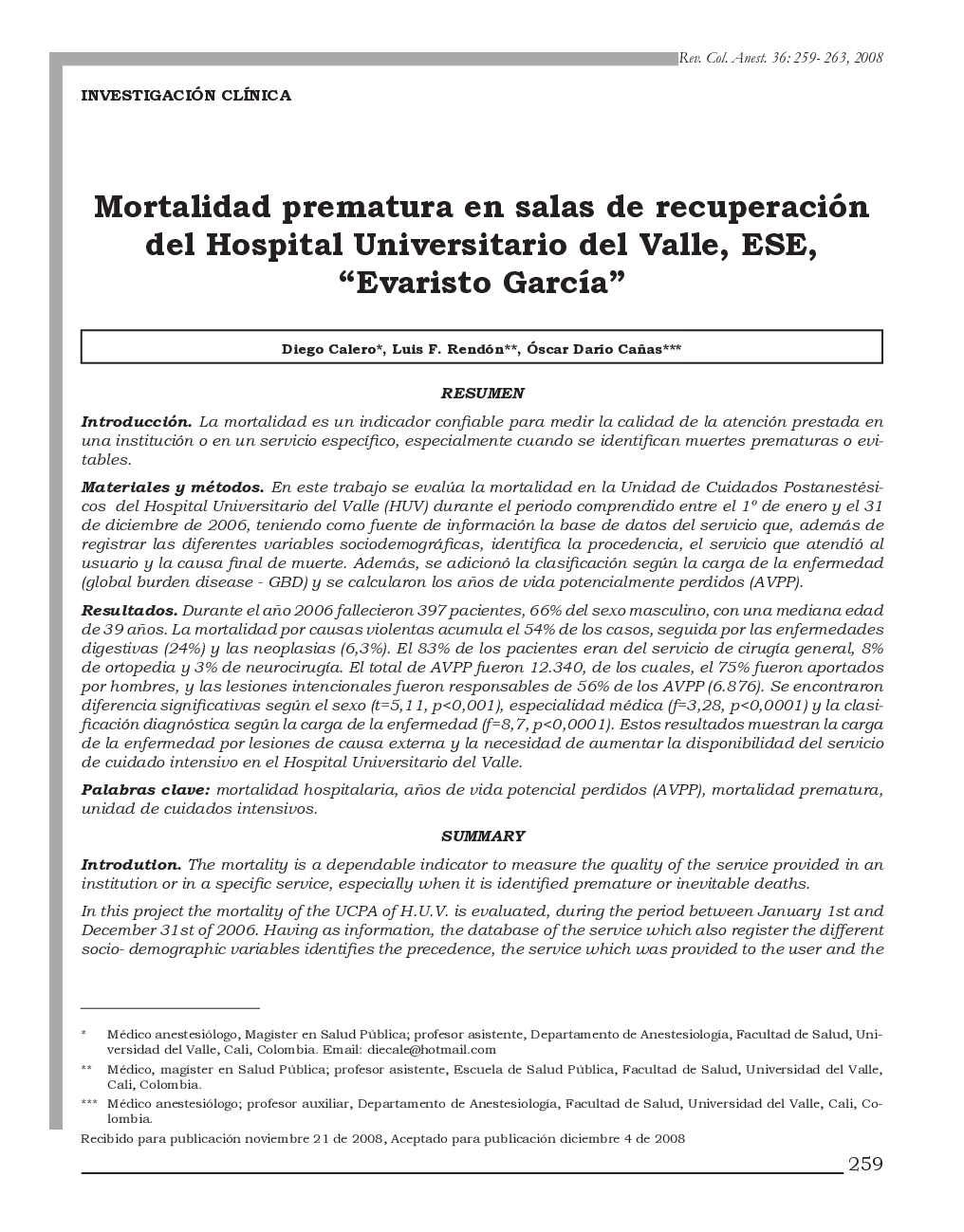| Article ID | Journal | Published Year | Pages | File Type |
|---|---|---|---|---|
| 2768051 | Revista Colombiana de Anestesiología | 2009 | 5 Pages |
RESUMENIntroducciónLa mortalidad es un indicador confiable para medir la calidad de la atención prestada en una institución o en un servido específico, especialmente cuando se identifican muertes prematuras o evitables.Materiales y métodosEn este trabajo se evalúa la mortalidad en la Unidad de Cuidados Postanestésicos del Hospital Universitario del Valle (HUV) durante el periodo comprendido entre el 1° de enero y el 31 de diciembre de 2006, teniendo como fuente de información la base de datos del servicio que, además de registrar las diferentes variables soáodemográficas, identifica la procedencia, el servicio que atendió al usuario y la causa final de muerte. Además, se adicionó la clasificación según la carga de la enfermedad (global burden disease - GBD) y se calcularon los años de vidapotencialmenteperdidos (AVPP).ResultadosDurante el año 2006 fallecieron 397 pacientes, 66% del sexo masculino, con una mediana edad de 39 años. La mortalidad por causas violentas acumula el 54% de los casos, seguida por las enfermedades digestivas (24%) y las neoplasias (6,3%). El 83% de los pacientes eran del servicio de cirugía general, 8% de ortopedia y 3% de neurocirugía. El total de AVPP fueron 12.340, de los cuales, el 75% fueron aportados por hombres, y las lesiones intencionales fueron responsables de 56% de los AVPP (6.876). Se encontraron diferencia significativas según el sexo (t=5,11, p<0,001), especialidad médica f=3,28, p<0,0001) y la clasificación diagnóstica según la carga de la enfermedad f=8,7, p<0,0001). Estos resultados muestran la carga de la enfermedad por lesiones de causa externa y la necesidad de aumentar la disponibilidad del servicio de cuidado intensivo en el Hospital Universitario del Valle.
SUMMARYIntrodutionThe mortality is a dependable indicator to measure the quality of the service provided in an institution or in a specific service, especially when it is identified premature or inevitable deaths.In this project the mortality of the UCPA of H.U.V. is evaluated, during the period between January 1st and December 31st of2006. Having as information, the database of the service which also register the different sociodemographic variables identifies the precedence, the service which was provided to the user and the cause of death. Also, in addition to the classification and according to “Global Burden Disease” (GBD), the life years potentially lost (AVPP) were also calculated.ResultsDuring the year of 2006, 397patients died 66% of which were males, with a median age of 39 years. The mortality by violent causes accumulates the 54% of the cases followed by digestive diseases 24% and cancer 6.3%. From all of the patients, 83% were from the General Surgery service, 8% from orthopedic and 3% from neurosurgery. The total of AVPP was 12.340 of which 75% was contributed for men and the Intentional injuries were responsible for the 56% of the AVPP (6.876). A significant difference according to genre t:5.11 p<0.001, medical specialty F:3.28 p<0.0001 was found and the diagnosis classification according to GBD f:8.7 p<0.0001. These results show the load of the disease for external cause injuries and the necessity of increase the availability of the Intensive Care Unit of the HUV.
